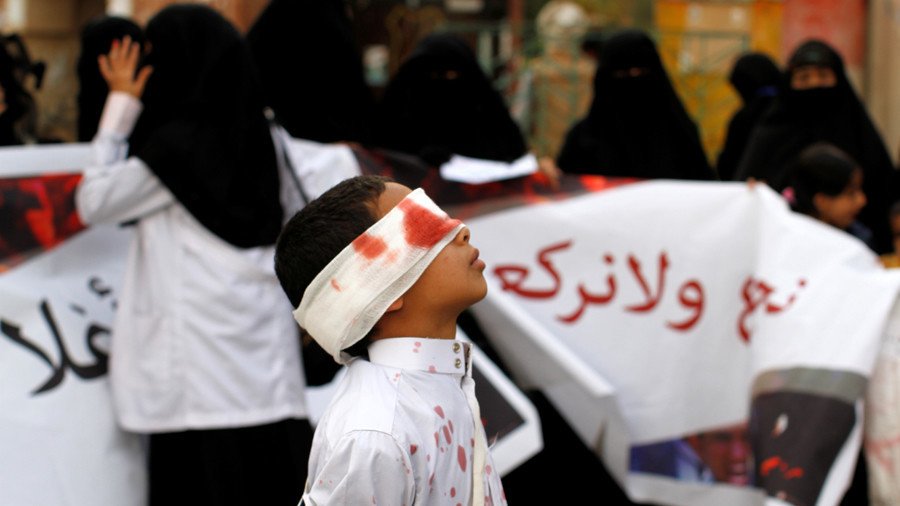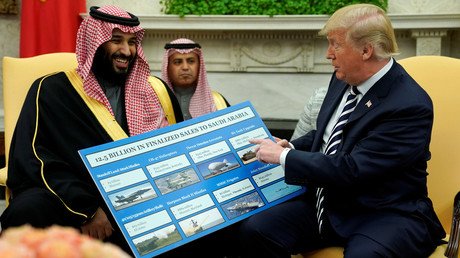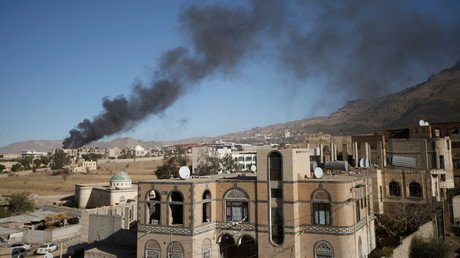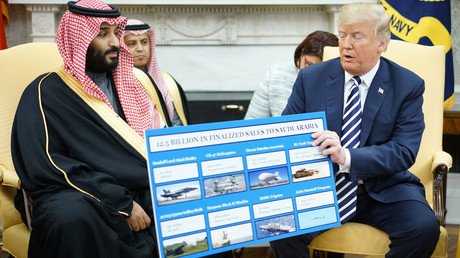3 years of Yemen bloodbath marked by US & UK arms deals with Saudis

Saudi Arabia’s military intervention in Yemen turns three, with no end to the bloodshed in sight. Riyadh’s ‘modernizer crown prince’ just got plenty of new weapons from US and Britain for the occasion.
It’s quite ironic that one of the biggest humanitarian disasters of our time stems from the events that were hailed in the West as a sign of great progress in the Arab world. The people have had enough, they are throwing down dictators and demanding political rights that are due to them, politicians and media said. The Arab Spring, the great democratization drive, ruled the headlines.
Arab Spring fallout
In reality, the 2011 wave of mass protests across the Muslim world came at a hefty cost for many of the countries affected: two years of turmoil and an Islamist government deposed by a military coup in Egypt. NATO-backed destruction in Libya. Bloodshed with no end in sight in Syria. Yemen initially seemed to be one of those who got away easy when its long-time leader Ali Abdullah Saleh agreed to step down in 2012 to be replaced by his Vice-President Abdrabbuh Mansur Hadi for a two-year transition period.
Under Hadi, Yemen, which was not stable to start with, was slipping into increased violence. But instead of giving way to a better replacement, he asked for one extra year in 2014. A year later, the Houthi, a militant Shiite group based in northern Yemen, allied itself with the former president, Saleh; and forced the new one to announce his resignation. Hadi then fled to Saudi Arabia and asked Riyadh to place him back in power, which the champion of Sunni Muslims gladly pledged to do. After all, Saudi Arabia sees the Houthi as nothing more than a proxy for their nemesis Iran. The intervention started on March 26.
This chain of events, which involved an armed coup in a deeply divided nation (Yemen was not even a single country before 1990) and an ousted president running to a foreign heavyweight, pleading to prop him up with troops, is hardly unique though.
Worst humanitarian disaster
The Yemeni adventure started with much fanfare for Saudi Arabia. The architect of the intervention, then-Defense Minister Mohammad bin Salman was lionized at home, sometimes literally in images on social media showing the “Saudi Lion” trampling “Houthi and Iranian rats.” His younger full-brother Khalid bin Salman, who now serves as ambassador to the US, personally flew sorties over Yemen. Another powerful prince, Al-Waleed bin Talal, offered to reward pilots of the Saudi warplanes with posh Bentley cars, but later backtracked.
غيرت صورة البايو ..طب و تخيّر صورتين للأسد محمد بن سلمان و كيف كمّـخ أذناب إيران pic.twitter.com/uYpuFiDe4f
— موجز الأخبار 🇸🇦 (@KSA24) 29 марта 2015 г.
Al-Waleed, an experienced businessman with extensive ties in the Western world, probably quickly realized that the award stunt would spark controversy, considering that, by then, it was quite clear that Saudi bombs were killing civilians by the dozen. Three years on, the bloodshed and human suffering in Yemen has got much worse, and Saudi Arabia was a major contributor.
Between March 2015 and February 2018, almost 6,000 civilians had been killed and 9,500 wounded, according to the UN Office of the High Commissioner for Human Rights. The Saudi-led coalition conducted over 16,600 air raids, with roughly a third of them targeting non-military sites, according to an Al Jazeera count. Almost 1,500 of them hit residential areas. Amnesty International says at least 36 of them violated international laws and may have constituted war crimes.
Saudi Arabia also imposed a naval and air blockade of Yemen. It restricts the supply of crucial goods like food, medicine and fuel, humanitarian aid, and access by foreigners, who could independently access and report the situation in the country. There is a strong argument that Riyadh is using what is termed siege warfare against its opponents in Yemen. It’s a time-tested tactic of having enemy troops and civilians cut off supply lines, constantly harassed by shelling and sniper fire, and ultimately starved into death or submission. It is also a war crime.
Yemen, the poorest nation in the Arab world, now has 8.4 million people on the verge of severe hunger – around 40 percent of its population. One million have been infected by cholera in the biggest outbreak of the waterborne disease in decades – an outbreak that probably would not have happened if Yemen’s water-treatment plants and hospitals had not been destroyed, and if its people had proper access medicine and healthcare.
The accomplices
Of course, Saudi Arabia is not the ‘bad guys’ to Houthi ‘good guys.’ As it often happens in civil wars, all sides in Yemen do horrible and criminal things. But the Yemeni bloodbath serves as a glaring example of Western duplicity in its attitude to wars. Riyadh would probably not have managed all this without help from its Western allies.
Mohammad bin Salman – who has come out on top in the Saudi palace struggle and is now the crown prince – received a red-carpet welcome in America just a week before the anniversary of his Yemen adventure. He was praised as a great modernizer, the personified hope for a new and better Saudi Arabia, giving its women at least some rights, and no longer finances radical preachers throughout the world. Interviewers didn’t challenge him much on Yemen, content with his blaming of Iran for the dire situation there.
He left with extra $1 billion worth of US-approved arms contracts, adding to billions upon billions of dollars in American arms that Saudi Arabia purchased previously. The money is “peanuts for you” US President Trump joked. Saudi warplanes dropped US-made bombs on Yemeni homes and are likely to continue doing so. The US does not bother to track where those bombs drop.
The crown prince’s visit to UK, another major supplier of arms to Saudi Arabia, went along the same lines – but with no charts showing off Tornado jets or Brimstone missiles from Prime Minister Theresa May. There were also hundreds of protesters demanding his arrest in London streets. The UK’s sales of arms to the Saudis jumped by almost 500 percent since March 2017, but May doesn’t have a “robust response” to the deaths those arms cause in Yemen.
Americans unaware
Remarkably, there was no significant public protest against Mohammad bin Salman during his visit to America. And it is probably no surprise. Senator Bernie Sanders, who led a failed attempt in the US Congress to cut American support for the war, lamented that many Americans are not even aware of Yemen’s plight, even less so of America’s role in it. The US not only arms the Saudis, but also provides air refueling and targeting for their warplanes.
Many Americans are unaware that the people of Yemen are suffering today in a devastating civil war, or that U.S. forces have been actively engaged in support of the Saudi coalition in this war.https://t.co/hcOGRJGaASpic.twitter.com/rr5BcyITta
— Bernie Sanders (@SenSanders) 13 марта 2018 г.
The American people are not to be blamed though. When their media consider “Russiagate” stories 50 times more newsworthy than the situation in Yemen, it takes a curious mind to become aware.
Alexandre Antonov, RT
@alantonov















